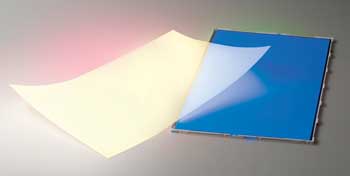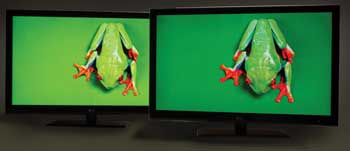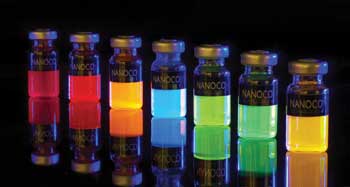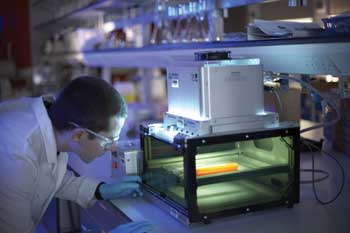Since their discovery in the 1980s, quantum dots have been quietly gaining momentum, making slow but steady headway in applications from displays and lighting to photovoltaics and health care.
Unique and versatile, quantum dots (QDs) are no longer confined to the fringes of abstract research. They are finding their way into televisions, computer screens, lighting devices and even our bodies. With the promise of better light quality and unparalleled color performance, these minute particles also are popping up in some surprising places.
Because of their controlled excitation properties and ability to reflect in three dimensions, they can be easily tuned to provide the desired emission wavelength just by changing their core size – a process known as “size quantization effect.”
It is estimated that the QD market, valued at $64 million in 2011, will generate $7.5 billion by 2016 at a compound annual growth rate of 55.2 percent from 2012 to 2022, with the health-care industry taking a majority of the market, according to MarketsandMarkets’ Quantum Dots Market – Global Forecast and Analysis (2012-2022), published in October 2012.
Although not yet cleared for clinical use because of questions about their potential toxicity, quantum dots are being explored for the study of intracellular processes at the molecular level, for high-resolution cellular imaging and for in vivo observation of cell trafficking.
Biosensing methods based on QD bioconjugates are booming in the rapid detection of pathogens, and significant improvements are expected in early cancer diagnostics as well as nonconventional therapy of cancer and neurodegenerative diseases.
But the optoelectronics market, which includes QD lasers, QD LEDs and QD displays, is soon expected to surpass the health-care industry and to enjoy maximum growth from 2014 to 2017, according to the report.
QD LCDs
Nanosys Inc., a QD specialist based in Palo Alto, Calif., is working with display makers to integrate its quantum dot enhancement film (QDEF) into consumer products, including partnerships with supply-chain and manufacturing expert 3M Co. of St. Paul, Minn., and device makers Samsung Electronics Co. Ltd. and LG Electronics Inc., both based in Seoul, South Korea.

A sheet of quantum dot enhancement film (QDEF) rests on an LCD backlight unit. Nanosys already has delivered thousands of square feet of QDEF.
“Consumers are clamoring for better displays, and color quality is clearly the next must-have feature,” said Jeff Yurek, product marketing manager at Nanosys. “Apple, Samsung and other electronics manufacturers recently started including color performance of new devices along with standard metrics like resolution, brightness and contrast ratio.”
Yurek pointed out that today’s home televisions can display only 30 to 40 percent of the visual color spectrum, and mobile devices, only 20 to 30 percent. This means that the user is missing a large component of the visual experience.
“High-color-performance displays will make our digital viewing experience of movies and video games more lifelike,” he said. “Filmmakers and video game developers will be able to more accurately bring their creative visions to life. Even the average point-and-shoot camera now captures a much wider range of colors than today’s displays can show.”

The LCD display on the far right is powered by quantum dot enhancement film, enabling a much deeper range of greens.
Quantum dots enable LCD makers to tune the spectrum of light in the backlight to dramatically improve picture quality. They emit light at very precise wavelengths, which can be controlled by their size.
“We use a mix of different color-emitting dots to create the perfect backlight for your LCD,” Yurek said. “The result is richer, more saturated color that’s more true to life.”
So far, Nanosys has delivered thousands of square feet of QDEF to its customers in anticipation of scaling up production of commercial products in the very near future. We can expect to see quantum dot technology implemented in any size LCD form factor, ranging from mobile devices to notebooks to televisions and even larger screens.

Nanoco is fabricating cadmium-free QDs for a more environmentally friendly approach to LCD backlighting and LED lighting devices.
“Major LCD manufacturers are now testing the film, and we expect products incorporating the technology to be on shelves soon. We’ve designed this technology to give LCD manufacturers a competitive counterweight to OLEDs,” Yurek said.
In terms of the prices we can expect, Nanosys aims to deliver QDEF to the manufacturer on a cost-neutral basis; it says that display makers will be able to use cheaper blue LEDs to offset the cost of QDEF.
Another QD specialist, Nanoco Technologies Ltd. of Manchester, UK, is fabricating cadmium-free quantum dots for a more environmentally friendly approach to LCD backlighting and LED lighting devices.

Nanoco’s cadmium-free quantum dots can be incorporated into many different materials. Here, quantum dots of different sizes in solution are being excited by ultraviolet light – the color of light emitted is a function of quantum dot size.
This new class of quantum dots is based wholly on materials free of heavy metals. By not using heavy metals, Nanoco brings important environmental advantages – particularly for consumer products such as LCD displays and lighting – enabling OEMs to comply with legislation such as Europe’s Restriction of Hazardous Substances Directive, which restricts the use of cadmium, the main component of QDs supplied by other QD providers.
“Nanoco’s heavy-metal-free quantum dots offer similar levels of performance as their heavy metal equivalents but allow users of quantum dots to avoid toxic heavy metals and comply with environmental and safety legislation,” said Dr. Michael Edelman, CEO of Nanoco Group plc.
Although the company also is exploring the use of QDs for anti-counterfeiting and airborne pollution sensors, Edelman said LCDs and general lighting will be the first products and should be on the market in the next couple of years.
QD LEDs
Commercialization of QD-based LEDs is already well under way. In May 2011, Samsung Electronics entered into a comprehensive patent licensing and purchasing agreement with New York-based Evident Technologies Corp. for its quantum-dot LED technology.

QDs also could be useful for anti-counterfeiting efforts as well as for airborne pollution sensors, but LCDs and general lighting will be the first products. Here, Nanoco cadmium-free quantum dots in Schlenk tubes.
Meanwhile, Dr. Liangfeng Sun, an assistant professor at Bowling Green State University in Ohio, and his former colleagues at Cornell University in Ithaca, N.Y., have been working on infrared QD-based LEDs for use in technologies ranging from fiber optic communications to night-vision devices used by the military.
The team created infrared LEDs in the lab using nanocrystals in solution, producing record brightness and better performance at a dramatically lower cost.
Although Sun admits that the brightness of the LEDs is probably less than the typical commercialized product, the external quantum efficiency is about five times higher than that of commercial LEDs.
“For the commercial LEDs, the wavelength tunability is achieved by using different semiconductors as light-emitting materials, which is complicated and expensive,” Sun said. “Our wavelength tunability is achieved by tuning the size of the QDs; i.e., larger-size QDs emit longer-wavelength light, smaller QDs emit shorter-wavelength light.”
In the process, which was described in a recent issue of Nature Nanotechnology, two precursors are mixed in a flask, forming crystals upon heating. By varying the temperature and heating time, the crystals can be “tuned” to form different sizes for different purposes.
Unlike the traditional LED manufacturing process used in the semiconductor industry, which uses high temperatures and a high-vacuum environment, the method devised by Sun is less costly, does not require the vacuum environment and enables greater adjustment of the wavelength to meet different purposes.
Metamaterials and QDs
The reach of QDs also extends into the fascinating world of metamaterials. Researchers at The City University of New York (CUNY), Purdue University in West Lafayette, Ind., and the University of Alberta in Edmonton, Canada, are using quantum dots as a probe to investigate the properties of metamaterials in a bid to improve their performance.
Metamaterials are artificially engineered materials that are carefully structured so as to exhibit light properties that do not follow the normal rules of propagation. By using QDs in the vicinity of metamaterials, associate professor Vinod M. Menon of CUNY and colleagues have manipulated the emission of light and controlled its interaction with the material.
It is the spectral tunability and photostability of QDs that make them the ideal probe material, Menon said.
“QDs themselves were purchased from Evident Technologies,” Menon said. “The metamaterial was fabricated by us. The QDs were spin-coated onto the metamaterial, and the emission properties were studied using steady-state and time-resolved spectroscopic techniques.”
The challenge is to make better metamaterials, which could one day find applications in solar cells and LEDs, as well as quantum information processing that is far more powerful than today’s computers can achieve. The work appeared in the April 2012 issue of Science and demonstrates the great promise of QDs.
Quantum dots explained
Quantum dots are typically made from semiconductor materials and range from ~2 to 10 nm. The energy levels and bandgaps of semiconductors were once thought to be fixed, but it is now known that shrinking the semiconductor changes the bandgap.
This means that, when light energy is incident on the QD, electrons from one energy level will become excited and move into a higher energy level, leaving a hole behind. As the electrons relax and rejoin the hole, they emit energy in the form of light, the color of which is determined by the size of the QD.
Critically, when the electron and hole pair (known as an exciton) are confined to a space less than the Bohr exciton radius (a few to tens of nanometers), the semiconductor’s bandgap widens. The emitted light is therefore shifted toward the blue end of the spectrum. The smaller the confinement, the bluer the emitted light.
Scientists now can tune the wavelength of the emitted light by adjusting the size of the semiconductor, rather than having to use different materials to produce different characteristics.